Technology
Three-dimensional Anatomical Modeling
Data collection and preparation:

Frances Yeung and Dr Scott Beattie discuss mitral valve structure.
How do we create our anatomical models? We begin by collecting anatomical reference material from a wide range of sources. These materials include peer reviewed journal articles, anatomical textbooks, volume rendered three-dimensional models derived from real radiographic data sets, as well as consultation with physicians. Following data collection and interpretation, the anatomical models are constructed in a three-dimensional graphics application called Cinema 4D.
Modeling
Cinema 4D is a commercial modeling, animation and rendering tool that runs on both Mac and PC computers. Modeling with this application consists of building wireframe representations of structures. These wireframe structures serve as the base for polygonal meshes, which in turn create the surface features of the model. An analogy for this model building approach would be a tent; Tent poles define the shape of the tent while the fabric portion of the tent defines its surfaces.
To ensure that our models are accurate, we conduct periodic reviews with scientific content experts and physicians.
Once rough models are constructed and approved by our medical content experts, they can be refined with the addition of surface colours and textures to add a level of realism while improving the visual clarity of each model.
Rendering
An animation of the mitral valve, atrial view.
Click and drag your mouse on the heart model to rotate it.
Once the anatomy has been verified for accuracy, the model can be rendered or drawn by the application. A rendered wire frame becomes a two-dimensional image that creates the illusion of a three dimensional object.
Back to top of page
